Displaying items by tag: GP 14
GP 14 Sailor Curly Morris at 75 Proves Sailing is “A Sport for Youth of All Ages”
Curly Morris of East Antrim Boat Club in Larne has sailed in a number of boats over a long period, but the GP 14 has always been the love of his life writes W M Nixon. And in the GP 14 Nationals 2018 at Sligo in August, he was on top of his form, well in the frame and within sight of the overall title which was eventually taken by Ross Kearney.
"GP 14s from all over Ireland staged a mid-winter regatta to mark Curly notching the big 75"
Thanks to judiciously-timed joint replacements (he’s a surgeon himself), the veteran sailor continues to enjoy his sport while spreading the news about how important a vibrant class association is for good sailing. Thus one of the secrets of the GP 14’s enduring success in Ireland is its exceptionally strong and supportive class organisation, and one of the reasons Curly Morris gives international service as a member of World Sailing’s Classes Committee is thanks to his direct and beneficial experience of the exceptionally lively GP 14 National Association here.
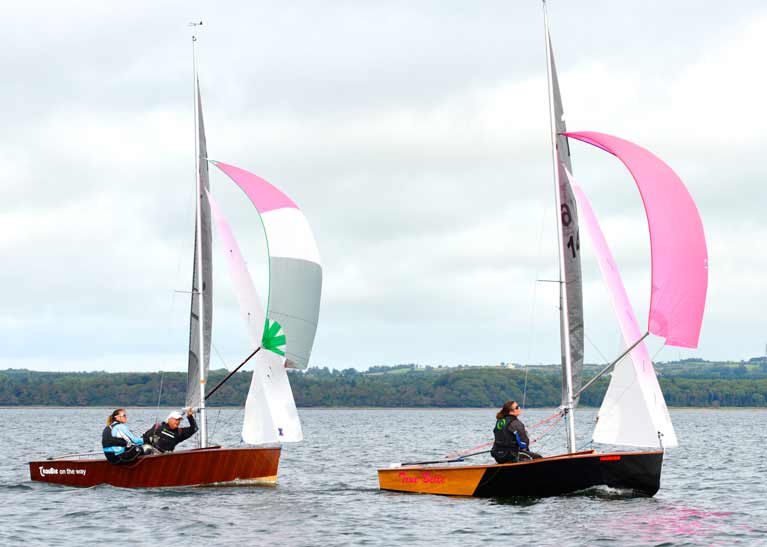 Veteran skipper Curly Morris (EABC) crewed by Laura McFarlane (Newtownards SC) chasing Ger Owens and Mel Morris (RStGYC) in the GP14 Nationals 2018 at Sligo. Photo: David Wray/Sligo YC
Veteran skipper Curly Morris (EABC) crewed by Laura McFarlane (Newtownards SC) chasing Ger Owens and Mel Morris (RStGYC) in the GP14 Nationals 2018 at Sligo. Photo: David Wray/Sligo YC
That said, not everyone wants to be pointed out as the guy who is still at the sharp end of dinghy racing at the age of 75, so until the latest GP 14 Ireland bulletin was posted yesterday, it had slipped under the radar for most of us that, back on January 5th in Skerries, a very elite group of GP 14s from all over Ireland got together to stage a mid-winter regatta to mark Curly notching the big seven-five. Andy Johnston of Sutton Dinghy Club takes up the story:
“CURLY’S 75TH CELEBRATION
Twenty-two brave GP14 sailors and 11 boats from Skerries Sailing Club, Sutton Dinghy Club, Newtownards Sailing Club, Donaghadee Sailing Club, Greystones Sailing Club, Youghal Sailing Club and Royal St George Yacht Club turned up on the chilly waters at Skerries on Saturday January 5th 2019, shaking off the holiday cobwebs for a fun-filled afternoon to honour one of the class’s legends, Curly Morris, who was celebrating his 75th birthday.
There were three short races pencilled in by Officers of the Day Olive Rooney and Sam Shiels. However, the sailors were so keen they requested a fourth race, as the eleven GPs enjoyed near-perfect conditions with 8-12 knots from the north-west providing ideal conditions for sailors who may have been worried about some off-season rust.
Gerbil Owens and Melanie Morris (RStGYC) showed great form for the start of the season, winning all the races in comfortable style, with Curly Morris (EABC), Hugh Gill (SDC) and Michael Cox proving consistent as usual. With boats travelling from both the north and south of Ireland, there was a fantastic competition, with tight racing from start to finish.
All sailors returned to shore for some well-earned drinks and toasties in the clubhouse, and then after sorting crews and boats into post-race mode, we wrapped up Curly’s 75th with a super night in the Red Bank in Skerries.
 The elite GP 14 group of hardy sailors who got together in Skerries to help Curly Morris celebrate his 75th birthday
The elite GP 14 group of hardy sailors who got together in Skerries to help Curly Morris celebrate his 75th birthday
With Curly’s family, 36-plus sat down for what was to be former GP14 sailor Terry McCoys last meal as chef-proprietor of the famous Red Bank Restaurant, which he built up to be a pillar of Skerries own special brand of hospitality, an establishment where food quality – especially seafood – was tops, but portion control was only in its infancy, making it a home-from-home for hungry sailors.
Curly said a few words, Hugh Gill said a few words on behalf of the GP14 Ireland fleet, and Terry said a few words. A great night, and we all left hoping we would be back somewhere in 5 years time for something similar. Congratulation Curly. #gp14legend
The afternoon’s sailing had kicked off an exciting programme ahead for Skerries and the GP14 class. Skerries Sailing Club is due to host the Irish Nationals later this year over the 16-17-18th August. And the Nationals, in turn, will be a great warm-up event for the World Championships that are due to be held at the Club on 25-31 July 2020. Both events are sure to attract sailors and their families from far and wide to what promises to be two great regattas.”
#dlregatta – With the Kinsale ICRA Nats/Sovereigns Trophy 2015 very successfully concluded last weekend, and a classic Dun Laoghaire to Dingle Race put stylishly in place before that, the feeling of another sailing summer busily in progress is all-pervasive. But while the image projected may well be one of stately progress by the cruiser-racer fleets along the Irish coast, taking in an offshore race here and a regatta there with much leisurely cruising in between, the reality is usually otherwise. For those boats doing significant segments of the programme, it's a case of fitting chosen events into the usual hectic early summer life of work and family commitments and exams and everything else, with the re-location of boats to the next venue being a hurried task undertaken by delivery crews.
Next week sees the mid-season peak of the sailing summer, with the four day Volvo Dun Laoghaire Regatta 2015 in Dublin Bay from Thursday July 9th to Sunday July 12th. In a way it is an amalgamation of all that has has already occurred in this year's season, together with new elements to make it a unique sailfest which celebrates the fact that the citizens of Ireland's capital city and their guests can be conveniently sailing and racing within a very short distance of the heart of town. W M Nixon sets the scene
In the dozen or so years since its inception, the biennial Volvo Dun Laoghaire Regatta has settled itself firmly into the sailing scene as an exceptionally varied event in terms of the boats and classes taking part. There are five regular cruiser-racer classes, plus an offshore division, fourteen one design keelboat classes, and nine dinghy classes. And although there are contenders from Ireland's north coast and from the Cork area and south coast too, together with one gallant entry from Galway, it is essentially an Irish Sea Sailfest, though with a remarkably strong Scottish presence.
However, it was on the coast of Wales at 8.0pm last night that this sailing celebration began, with an ISORA Race starting in Holyhead and heading for Dun Laoghaire to set this large and complex programme into action towards a culmination on Dublin Bay in eight days time with the conclusion of VDLR2015.
2015 marks the Bicentennial of the Royal Dee YC, which was founded in 1815 on the Cheshire shores of the River Dee estuary where northwest England marches with northeast Wales. Originally the Dee Yacht Club (and founded, it's said, a month or two before the Royal Yacht Squadron came into being in the south of England, making the RDYC the second-oldest Royal yacht club in England after the Royal Thames), the Cheshire club became the Royal Dee YC in 1847.
Although the great prosperity of Liverpool in the 19th century saw the club's fleet of substantial yachts gathered in the Dee and then increasingly in the Mersey, by the late 1900s it was looking to the Menai Straits area as the focus of its keelboat events. As well, the completion of Holyhead breakwater in 1873 added a new and important harbour to its list of possible big boat sailing locations, and there was an increase in the number of cross-channel "matches" which the Royal Dee and the Royal Mersey, in conjunction with the Dublin Bay clubs, had already been running for some years.

A Royal Alfred YC cross-channel match from Dublin Bay to Holyhead gets under way in 1888. Cross-channel links were strong in the latter half of the 19th Century, and with the new breakwater completed at Holyhead in 1873, a new venue was available both for the Irish clubs and those on the other side such as the Royal Dee and the Royal Mersey

The bicentenary logo of the Royal Dee YC. In 1815, this club on the Cheshire coast was founded shortly before the Royal Yacht Squadron in the souh of England, whose Bicentennial is being celebrated at the end of July.

Dun Laoghaire saw its first regatta staged in 1828, and participation by yachts from the northwest of England and North Wales was regularly recorded. This is the Royal St George YC regatta of 1871.
So when we say that the Royal Dee has always been a stalwart of offshore racing in the Irish Sea, we're not referring to a story spanning only the 20th and 21st Centuries. On the contrary, it goes well back into the 1800s. And now, with the revival of keelboat sailing in the Mersey with several of Liverpool's myriad docks being given over to recreational use, we have in a sense come full circle with enthusiastic Dublin Bay support of the Bicentennial celebrations reflecting sailing links which go back almost 200 years
The Lyver Trophy is the Royal Dee's premier offshore challenge, and this year it is special, as it's a fully-accredited RORC event counting for points in the annual championship, and a highlight of the ISORA Programme 2015. It's start scheduled for yesterday evening in Holyhead will see the fleet – mostly regular ISORA contenders – sail a course of at least a hundred miles before finishing in Dun Laoghaire. Then as VDLR 2015 gets under way, races in it, combined with the Lyver Trophy results, will count as part of a series towards finding an overall winner of the RDYC Bicentennial Trophy.
Only entrants in the Lyver Trophy race are eligible, and for that race itself – which can be followed on the Averycrest Yellowbrick Tracker - the favourite has to be the Shanahan family's J/109 Ruth, still buoyed up by her great victory in the Dun Laoghaire to Dingle Race three weeks ago.

Back in The Bay – the Shanahan family's J/109 Ruth will be back in her home waters of Dublin Bay after winning the Dun Laoghaire to Dingle Race and completing the Lyver Trophy Race from Holyhead which started last night. Photo: David O'Brien
At the other end of the size scale, the VDLR2015 Dublin Bay programme includes several dinghy classes, and the biggest fleet will be mustered by the International GP 14s, who have designated the racing in Dublin Bay as their Leinster Championship. In an interview with Sailing on Saturday in March, VDLR Chairman Tim Goodbody emphasised that, overall, the event should be seen as a regatta rather than a championship, and for most boats that's just what it will be. But the GP 14s with their great esprit de corps have always done things their own way, and with their compact boat size – albeit comprising a large fleet of dinghies – they reckon they can get in a proper championship while sharing in the fun of the event.
 The brothers John and Donal McGuinness of Moville Sailing Club in Donegal are expected to be among the pace-setters in the GP 14 class with their superb Alistair Duffin-built boat. Photo: W M Nixon
The brothers John and Donal McGuinness of Moville Sailing Club in Donegal are expected to be among the pace-setters in the GP 14 class with their superb Alistair Duffin-built boat. Photo: W M Nixon

The GP 14 Ulsters 2015 were recently won on Lough Erne by Shane MacCarthy & Damian Bracken of Greystones
As to who is favourite, the McGuinness brothers – Donal and John - from Moville in Donegal, with their top-of-the-line Duffin boat built in Northern Ireland, have to be in the reckoning after being top Irish at last year's Worlds on Strangford Lough, but there's fresh blood in the fleet with the newest class developing at Youghal, while this year's recent Ulster Championship on Lough Erne was won by the Greystones duo of Shane MacCarthy and Damian Bracken.
The dozen and more boats coming south from Scotland, most of them substantial cruiser-racers, are testimony to a growing trend in sailing on Europe's Atlantic seaboard. Given a choice of venues, your average yachtie on this long coastline will incline to head south if at all possible. Other things being equal, it's reckoned the further south you go the warmer it is likely to be. And from the upper reaches of the Firth of Clyde, there are times when Dublin Bay might seem like the distant and sunny Mediterranean.
Maybe so, but we'd caution that much depends on the moods and location of that all-powerful weather determinant, the northern Polar Jetstream. In July, so long as it's well clear of Ireland -whether to the north or the south - we will have glorious high summer, and that occurred for the previous VDLR back in 2013, where the photos speak for themselves.
So we hope for the best in looking forward to welcoming a fleet of around 415 boats to Dun Laoghaire between July 9th and 12th, with all four of our in-harbour yacht clubs extending the hand of hospitality in a regatta tradition that goes right back to 1828. But while heritage and ceremonial are all very well in their place, it's the prospect of good sport which energises the participants and their sailing, and with several major contests already logged in 2015, what can we expect on the leaderboards next week?
At the top of the tree, Class 0 has formidable competition, including former Scottish champion Jonathan Anderson racing his XP38i Roxstar against the Royal Cork's Conor Phelan with the Ker 37 Jump Juice, which was one of the best performers in last year's ICRA Nationals at the same venue, and this year again became a force to be reckoned with as the breeze sharpened in the four day Kinsale ICRA Nats 2015/Sovereigns Cup a week ago.
 Freshly squeezed – her storming finish to last weekend's final race of the ICRA Nats/Sovereigns Cup at Kinsale makes Conor Phelan's Ker 37 Jump Juice one of the top contenders in the VDLR2015. Photo: David O'Brien
Freshly squeezed – her storming finish to last weekend's final race of the ICRA Nats/Sovereigns Cup at Kinsale makes Conor Phelan's Ker 37 Jump Juice one of the top contenders in the VDLR2015. Photo: David O'Brien
With a win in the final race, Jump Juice came in second to seasoned campaigner George Sisk's class overall winning Farr 42 WOW (RIYC), the pair of them in turn displacing the early leader, lightweight flyer Mills 36 Crazy Horse (ICRA Commodore Nobby Reilly & Alan Chambers, HYC) down to third in the final day's racing, so Crazy Horse will be hoping for a return of lighter breezes when racing starts next Thursday on Dublin Bay.
In the previous Volvo Dun Laoghaire Regatta in 2013, the most successful boat in was Nigel Biggs' much-modified Humphreys Half Tonner Checkmate XV, but this year the Biggs team is racing as Checkmate Sailing with the newest boat in the fleet, the Mark Mills-designed American-built C & C 30 OD Checkmate XVI. She may be only 30ft LOA, but she's such a hot piece of work with so many go-fast bells and whistles that she has a rating of 1.140 to put her in Class 0.
The oldest boat in the cruiser-racer fleets will be found in Class 3, where the 44ft Huff of Arklow is making an historic return to Dublin Bay racing. Originally built in 1951 by Jack Tyrrell of Arklow to a design by dinghy genius Uffa Fox, Huff is so-called because her concept is reckoned three-quarters Uffa Fox and one quarter Douglas Heard. The latter was the founding President of the Irish Dinghy Racing Association in 1946, and he later went onto to become Commodore of the Royal St George YC and a noted cruising and offshore racing enthusiast with this unusual boat, which is like a very enlarged Fying Fifteen with a lid – in fact, with her 30ft-plus waterline, she was described as a Flying Thirty. In recent years she has undergone a total restoration with Cremyll Keelboats near Plymouth in Devon, and Dominic Bridgeman of the Cremyll group will be racing her with trainee crews in her old home waters of Dublin Bay.

The Flying Thirty Huff of Arklow racing off Dublin Bay while under Douglas Heard's ownership in the 1950s. Built by Tyrrell's of Arklow in 1951, the hugely innovative Huff has recently had a major restoration, and will be making her return to Dublin Bay to take part in VDLR2015.
Among the newer boats on the bay, the 2013 champion Checkmate XV is still very much in the picture, but now she's owned by Howth's Dave Cullen, and took second overall in class in the Kinsale series a week ago. In Dun Laoghaire next week, she's with other Half Tonners at the lower end of the Class 2 rating band on 0.944, almost 200 rating points below the new Biggs boat. Class 2 also includes the Division 3 winner at Kinsale, Richard Colwell & Ronan Cobbe's Corby 25 Fusion (HYC) which bested VDLR 205 Chairman's Sigma 33 White Mischief in a real duel after they went into the final day's racing equal on points, while another Kinsale success story in the Class 2 lineup is Paddy Kyne's X302 Maximus from Howth, overall winner of the Portcullis Trophy for top ECHO boat.

Dave Cullen's modified Half Tonner Checkmate XV will be looking to take the top slot on Dublin Bay after being runner-up in Kinsale. Photo: David O'Brien
In between the two Checkmates on ratings, we find most of the cruiser-racer fleet, with Class 1 shaping up some interesting competition between the likes of Paul O'Higgins Corby 33 Rockabill (RIYC), Kenneth Rumball skippering the Irish National Sailing School's Reflex 38 Lynx, and two very sharp First 35s, Prima Luce (Burke, Lemass & Flynn, NYC & RIYC) and another former Scottish Series champion, John Corson (Clyde Cr C) with Salamander XXI.
This year's Scottish Series Champion and the Afloat.ie "Sailor of the Month" for May, Rob McConnell of Dunmore East, will certainly be racing in the VDLR 2015, but whether or not it's with his all-conquering A35 Fool's Gold (second in class at Kinsale) or aboard another boat (a Flying Fifteen) remains to be seen. And the Top Sailor Count doesn't end there, as there'll be at least four Olympic sailors involved in four different classes, with Robin Hennessy racing in what has all the marks of a quality International Dragon fleet against the likes of former Edinburgh Cup winner Martin Byrne, Annalise Murphy racing in the Moths which will surely be a change from the Water Wag which she raced with her mother Cathy MacAleavy (also another ex-Olympian) last time round, and Mark Mansfield helming John Maybury's J/109 Joker 2. After Joker 2's class overall win in Kinsale, we can expect a battle royal in the J/109s with boats of the calibre of Ruth for the National title fight.

The Shipman 28s find that the sport and socializing which the VDLR guarantees will provide some of their best racing of the year. Photo: VDLR
The J/109s are the queens of an impressive array of One Design keelboats which includes Sigma 33s (where VDLR 2015 Chairman Tim Goodbody's White Mischief is racing under the command of Paul McCarthy), Beneteau First 31.7s, Shipman 28s having one of their best gatherings of the year, Ruffian 23s with a good turnout, the attractive First 21s which are steadily gaining traction as a Dublin Bay class, and best OD keelboat turnout of all is by the Flying Fifteens, nearly all of them under the NYC flag.

Olympians all – in VDLR2013, Olympic sailors Cathy MacAleavey (1988) and her daughter Annalise Murphy (2012) raced the family Water Wag Mollie. But while Cathy will be sailing Mollie again this year, Annalise will be on her own racing a foiling International Moth.

Newest of the oldest – Adam Winkelmann and Doug Smith's new French built Water Wag No.46, Madameoiselle, has been launched in time for the regatta. Photo: Owen McNally

The Howth 17s of 1898 vintage will be the oldest class racing. Photo: David Branigan
Veteran classes include the IDRA 14s from 1946, the Glens from 1945, the Howth 17s of 1898 which pre-date the 1902 Water Wags, and the 1932 Mermaids, the latter being in the interesting position of no longer having an official division in Dun Laoghaire, yet it's a Dun Laoghaire skipper, Jonathan O'Rourke of the National, who continues to dominate the class both at home and away.
With large fleet numbers afloat guaranteed, the shoreside programme is appropriately busy, with the official side of each day's racing concluded by the evening's daily prize-giving at one of the four waterfront clubs. But with so many sailors involved, there'll be action in all the clubs – and at other establishments in Dun Laoghaire - throughout the week. The scene is set, let the party begin at a venue which has been staging regattas since 1828.
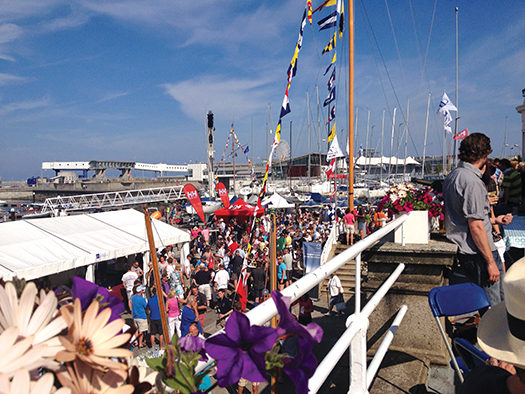
When the summer comes, the après sailing at the VDLR is world class. Photo: VDLR
Further reading:
Download the full entry list for Dun Laoghaire Regatta 2015 class by class below
Download the Sailing Instrcutions for Dun Laoghaire Regatta 2015 HERE
- Dun Laoghaire Regatta
- Volvo Dun Laoghaire Regatta
- Royal St George Yacht Club
- Royal Irish Yacht Club
- National Yacht Club
- ISORA
- Water Wags
- Royal Alfred Yacht Club
- yellowbrick
- GP 14
- Nigel Biggs
- George Sisk
- Annalise Murphy
- Half Tonners
- Tim Goodbody
- Mermaid
- Fool's Gold
- Dragon
- Irish National Sailing School
- Kenneth Rumball
- Dublin Bay
Boating Visitors To Ireland's South Coast Get Mixed Welcome Messages
#marinetourism – Ireland's south coast provides an almost infinite variety of harbours, natural havens, and extensive areas of interesting sailing water. These cater for boat enthusiasts of all kinds, with craft of every type. So how does the welcome for visitors shape up? W M Nixon contrasts the different hospitality styles of four attractive ports.
The word on the grapevine that the Ballydehob Old Boat festival had taken place arrived with an intriguing photo from Anthony O'Leary. It had been noted in the interview with him immediately after he had led the team in Ireland's Commodore Cup Victory, that while he was trying to unwind for a while, it's not really in the O'Leary makeup to relax, and soon his mind was busy with new ideas of nautical interest.
Nevertheless he was cruising gently in early August down towards West Cork in the family's handsome big Nelson powercruiser Irish Mist, a fast and able vessel which his father Archie and mates like Mick Ahern once took right round Ireland in a settled springtime spell of weather, just to be in Dublin to watch Cork Con play rugby in some major championship at Lansdowne Road.
As it turned out, this year Irish Mist was getting down west ultimately to be in Baltimore for the 1720 Nationals in late August, which O'Leary duly won. But from time to time, he flashed back some photos of interesting boats met along the way, and one which really rang the bell was a little Ette Class clinker-built gunter-rigged sloop sailing in Castlehaven.
The Ette class originated way way back, when two keen dinghy cruising types sailed their little dinghy into Castlehaven, and the Castletownshend locals in the South Cork Sailing Club were so taken by the boat that they commissioned the waterfront boatbuilders, the O'Mahony brothers, to build some sister ships as the basis of a class.
All the new boats' names ended in "ette". And the class survived for many years, though at times the Ettes were hanging on by a thread. But recently it has had a fresh lease of life with new examples of what is now a classic dinghy being built by Lui Ferreira of Ballydehob, who last came through this parish when, in 2012, he put the first teak deck on a vintage Howth 17, the syndicate-owned Deilginis.
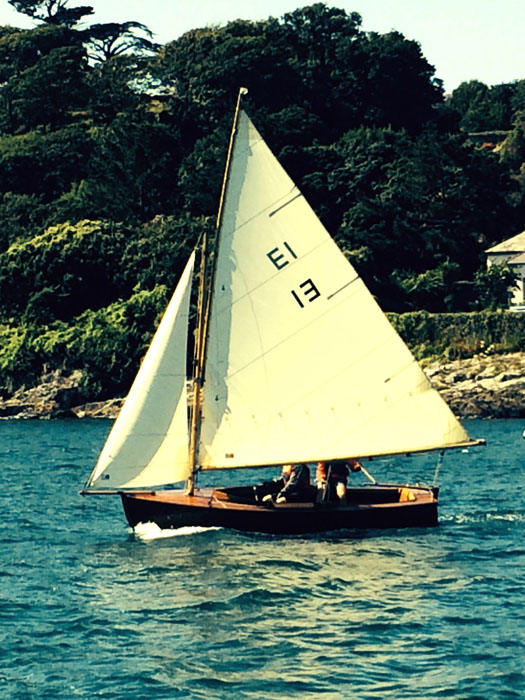
Perfection of summer – an Ette class in her home waters of Castlehaven. Photo: Anthony O'Leary
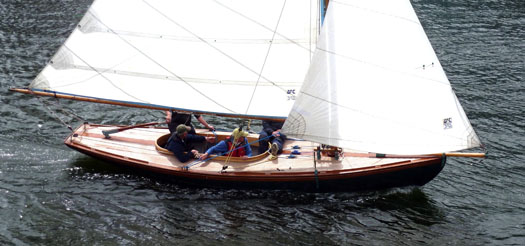 Rui Ferreira, builder in Ballydehob of the Ette Class, also put this teak deck on the 107-year-old Howth 17 Deilginis in 2012. Photo: W M Nixon
Rui Ferreira, builder in Ballydehob of the Ette Class, also put this teak deck on the 107-year-old Howth 17 Deilginis in 2012. Photo: W M Nixon
A Howth 17 looks well no matter how you photo her. But an Ette is a quirky little thing which can sometimes look odd from the wrong angle. Yet in a flash of inspiration, the Captain of the Commodore's Cup team took up his iPhone as an Ette came bustling down Castlehaven on fine sunny morning, and we got what I reckon to be one of the best photos of an Ette under way ever obtained – plus it gets the very essence of summer in Castlehaven.
The next O'Leary snap some days later was just briefly titled: "The Ballydehob Old Boat Festival, Irish Mist in archway second left". What was going on here? We'd heard vague stories about a very relaxed assembling of boat at high water at the drying quay at Ballydehob, but the O'Leary photo hinted at serious numbers and a high level of organization.

The teaser photo – first intimations of this year's Ballydehob Gathering of the Boats, with the O'Leary family's motor-cruiser Irish Mist (framed in the second arch from left) joining an eclectic group of 74 boats for a couple of hours at top of the tide. Photo; Anthony O'Leary
 This is most people's image of Ballydehob, crowded and very rural, with Mount Gabriel beyond. Only the more observant will notice the tidal river in the foreground. Photo: W M Nixon
This is most people's image of Ballydehob, crowded and very rural, with Mount Gabriel beyond. Only the more observant will notice the tidal river in the foreground. Photo: W M Nixon
To begin with, most casual visitors would scarcely think of Ballydehob as a seaport at all. Rather, it's the very essence of rural West Cork, a crowded little village where "laid-back" is the default mode, and it has been so for some time. It reached something of an apotheosis when Annie Barry (she's one of the Fergusons of Gubbeen Cheese) was running her wonderful Annie's restaurant on one side of the winding main street, and the Levis sisters Julia and Nell, feisty little ladies of mature years, were running Levis's pub across the way.
Julia and Nan were splendid folk of considerable standing, and it's said the pair of them were once squired to the West Cork Hunt Ball in Skibbereen by Jeremy Irons of Kilcoe Castle a few miles along the coast. As for the setup in Ballydehob, space was so limited in the restaurant that, having checked out your booking, you simply took up station in leisurely style across the street in the pub with Annie's menus and an aperitif or two, then Annie would come across the road and discuss your order, and a delightful evening would continue late into the night.
Alas, for some year now Annie's has been closed, though everyone lives in hope of somebody re-opening it. And in the pub, the old ladies have passed on. But now it's run by a great-nephew, and very successfully too. We got ourselves in there late on a velvet July evening this year to find the place was heaving with youth and beauty and high fashion in casual style - achingly trendy it has become.
It could have been a traditional local in any of the world's fashionable holiday areas except for one thing. A ball of fur, a terrier of some kind, emerged from among people's legs and barked its head off at me. I assumed it was because I carried a whiff of our own little Jack Russell. But the blushing girl owner told me with a big smile that her little dog must have thought I was a priest. Only along Ireland's south coast, near some former or still surviving Protestant enclave, would you have heard that particular excuse.
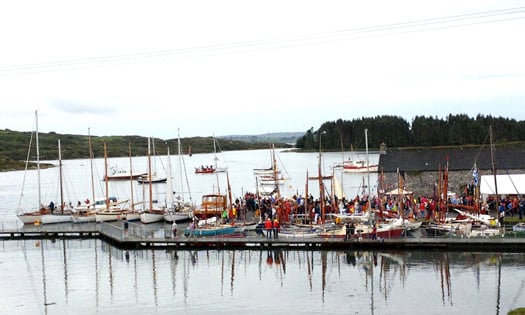 The old dock at Ballydehob is well able to receive a very varied fleet, seen here from the old railway viaduct Photo: Miriam Jones
The old dock at Ballydehob is well able to receive a very varied fleet, seen here from the old railway viaduct Photo: Miriam Jones
Just along the river from these scenes of hospitality and minor mayhem, immediately below the mighty railway viaduct which seems to be so disproportionate for the long-gone needs of the little West Cork Railway, there's Ballydehob Harbour. Time was when it was key to the place's economy, and it was in the late 1930s, only a year or so before World War II, that the Brooklands, the last surviving sail-only coasting schooner to deliver cargoes to West Cork, made her way up the winding estuary at the head of Roaringwater Bay (it's named for the Roaringwater River, much of the bay behind Carbery's Hundred Isles is well sheltered), to anchor just off the quay, as she was too deep to berth alongside.
The Brooklands was owned and skippered by Tom Creenan of Ballinacurra in the inner northeast reaches of Cork Harbour, but it was from Birkenhead or Goole on the Mersey that she'd bring her welcome cargoes of coal, a challenging passage at the best of times. At Ballydehob, while smaller cargo-carriers could get alongside the old quay, the Brooklands discharged her cargo into the multi-functional barge-type vessel known the Sandboat.
She was used by her owners, the Levis family, for just about everything, but primarily for going out among the islands towards high water, running up on a clean beach, then laboriously shovelling sand into the hold until the tide returned and the Sandboat could be floated off and piloted back to the quay where her eventually very useful cargo would be shovelled ashore to become builders' supplies.
The Sandboat was Queen of the Fleet at Ballydehob, and she played such a central role in the Levis family's life that Old Boat Festival organiser Cormac Levis's brother calls his pub in Ballydehob the Sandboat.
As for how Cormac himelf first got the notion for the Ballydehob Gathering of the Boats, he has been a tower of strength in the Traditional Boat movement, particularly in West Cork but also throughout Ireland, for many years. And with others following his example in restoring or even building new sailing lobster boats to traditional design, he suggested that getting together at Ballydehob during the little town's time-honoured summer festival around August 15th might hit the spot. And for the first one in 2004 –making this year's the tenth anniversary - they assembled nine boats, which was considered pretty good going.
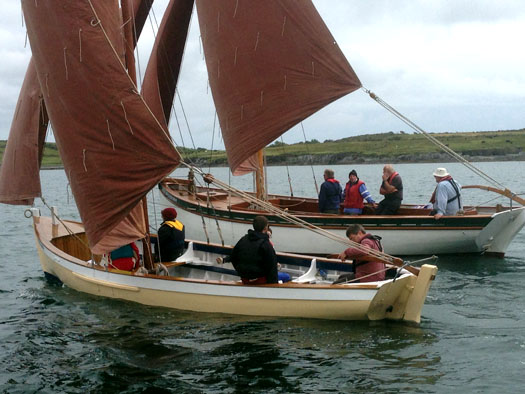
Close-up on Cormac Levis's lobster boat, which led the way for the first gathering of traditional craft at Ballydehob in 2004. Photo: Brian Marten
From it, they learnt that, for the future, while the aspiration would of course be for quiet and easy-going organization under a light hand, underneath it all there'd have to be efficiency, always with an eye on the clock. Although the tidal window is more than two hours for most boats, they've successfully accommodated modern yachts up to two metres draft without anyone being left behind stuck on the mud. But with limited manoeuvring space in both the harbour area and the channel, once the witching hour of high water is upon the fleet, it's time to start thinking about an orderly departure after two solid hours and more of good crack, mighty barbecues, and much interest in an examination of other people's traditional and classic boats.

Even among the sister-ships of the lobster fleet, many individual variants in hull lines and rig are apparent. Photo: Brian Marten

Just to add to the variety and colour, the Ilen Trust from Limerick brought their much-travelled Shannon Gandelows (right) to Ballydehob. Their stylish pennants are a legacy of heir successful visit to Venice at the end of April this year. Photo: Gary MacMahon
So the crucial thing is to select the ideal Saturday nearest to August 15th with a good big tide in mid-afternoon. As the Boat Gathering is such a force in its own right, they can range quite extensively on either side of August 15th, and to date the earliest has been August 8th, while the latest was August 21st.
This year's was Saturday August 9th, and while there may have been rain later in the day despite West Cork having much more sunshine in August than almost any other part of the country, no-body now remembers the rain as they recall the sheer fun and sense of community of what has been described by Tiernan Roe, another of the quality boat-builders of Ballydehob, as the "shortest bestest Boat Festival in the World".

Yet another creation of the active Ballydehob boat-building scene. This is an attractive little Cape Henry 21 cutter lunched in June by Tiernan Roe of Roe Boats. Photo: Tiernan Roe
For this year, it attracted 75 boats, though admittedly last year's record entry of 50 boats was greatly enhanced by this year's decision by the Drascome Lugger Association to combine Ballydehob in their 2014 cruise-in-company in West Cork, thereby adding 27 boats at a stroke.
But even with 27 boats of one class, the variety across the fleet as a whole was remarkable. So how do they assemble such a disparate fleet of boats with obviously highly-individual skippers, in such a quietly efficient way? For you'll never see or hear the Ballydehob Gathering of the Boats being publicly advertised all that much beforehand.
The method is perfectly simple. Everyone with an interest will know it is likely to be coming up on the agenda. So a month and more beforehand, Cormac will text them with the final date on a need-to-know basis. It works, and it sets the tone of quiet consideration for others and their boats in a very special festival in which some quiet sponsorship by CH Marine and West Cork-based German traditional boat fan Thomas Drewes sees that all participants get mementoes including cherished T-shirts (definitely not for general release), while barbecue facilities keep the good humour buzzing until everyone departs in style for their anchorage for the night, for although most boats hope to be berthed in Ballydehob on the big day more two hours hours before high water, once the ebb has started the channel has become much less forgiving about any pilotage errors.
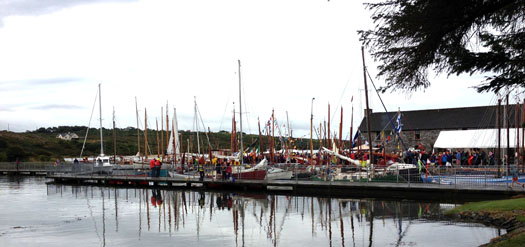
They're all here, as neatly berthed as you could please, but getting them away as the ebb starts requires good seamanship and boat-handling skills. Photo: Miriam Jones
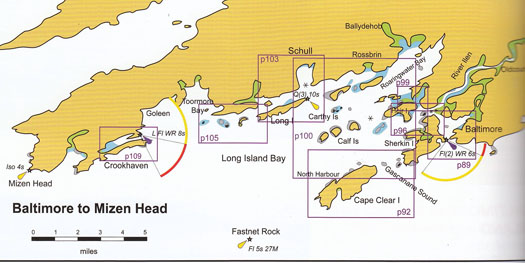
Ballydehob's central position in a hugely varied and welcoming crusing coast is emphasized by the number of other harbour chartlets indicated in this plan of the prime cruising area of West Cork. Plan Courtesy Irish Cruising Club
It's good to see a locally-focussed event like this now coming of age with a very healthy turnout. Eastward along the south coast, last weekend saw another event which will surely grow in stature and numbers, the second staging of Y2V Cruise-in-Company on the River Blackwater up the estuary from East Cork to West Waterford, as a flotilla of ten boats - eight GP14s, a Mermaid and a Feva – sailed up-river from Youghal to Villierstown.
It has been promoted by Youghal schoolboy GP 14 skipper Adrian Lee, and last year the inaugural tiny flotilla managed most of the sailable river by going to the bridge at Cappoquin before returning downriver to Villierstown. This year it achieved deserved support from the GP 14 class, with the furthest road-trailed from sea level being incoming Irish GP 14 Association President Stephen Boyle from Sutton DC, while the furthest-travelled in terms of elevation above sea level were the Blessington group, who came down from the Wicklow Hills with their Geeps and included Richard Street and kids (see again this blog on 26th July), and a brand new Duffin boat belonging to Simon Culley and Libby Tierney.
As for seniority, the classic of the class was a 60-year-old beautifully-restored Bell Woodworking GP 14 owned and skippered by 16-year-old Jack Nolan, another of that group of Youghal youngsters who are taking local dinghy sailing forward with gusto, while further variety was provided by Norman Lee of Greystones, his crew including the inevitable family pooches which are such a part of the GP 14 scene.
The sailing was mixed – as Norman said, in a river the wind will always be ahead some time, and though we think of the secret Blackwater Estuary as being fairly straight, in fact there are some quite significant curves. It took about four-and-a-half hours to sail up, and a brisker four hours to return on Sunday morning's ebb.
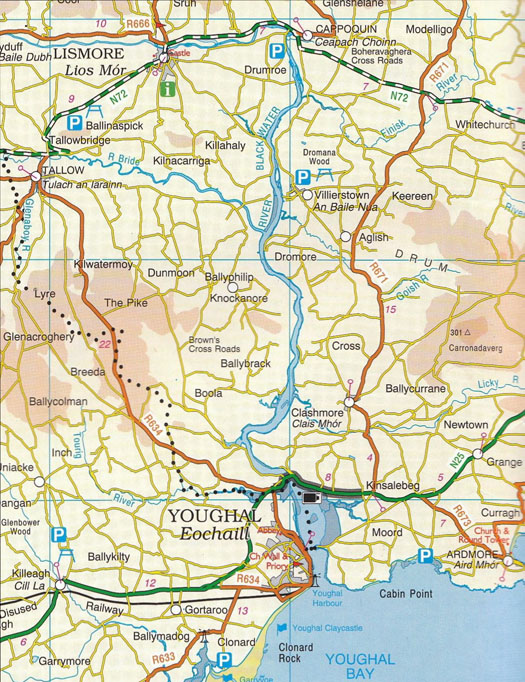
The secret waterway – the Blackwater Estuary from Youghal up to Cappoquin and almost to Lismore is one of Ireland's least-sailed rivers

Villierstown's new clubhouse, open only three weeks, was ready and willing to make welcome the crews who had sailed up from Youghal. Photo: Norman Lee

The new facility, Villierstown's "floating pier"
(right), was originally the in-harbour pontoon at Dungarvan SC. Photo: Norman Lee
At Villierstown, the new clubhouse of the Villierstown Boating & Activites Cub had been open only three short weeks, but they've made good use of a sports council grant, and it well fulfills a multi-purpose role, including providing the hospitality needed by sailing campers, with Paul Virtue and his wife Caroline organising a fine feast in the clubhouse on the Saturday night, and an enormous breakfast on Sunday to send them on their way downriver to round out an event which has future annual success written all over it.
One of the reasons it all went so well was that the slightly cogglesome little plastic floating jetty, along which the sailors of Villierstown used to access their small boats, has been replaced by a proper pontoon which the club acquired when Dungarvan SC eastward along the coast up-graded their in-harbour pontoon. In fact, Dungarvan support for the development of Blackwater sailing didn't stop there, as one of the fleet in the Y2V was a vintage Dungarvan-based Mermaid in which owner Eugene Burke has cruised the entire south coast between Ballycotton and Kilmore Quay.
The boat is Akita, Mermaid No. 85, and she has certainly been around, as she was built in the Barkyard in Skerries in 1953 by Joe and Matt Boylan. The Barkyard was originally the place where the Skerries-based coasting schooners and fishing boats had their sails preserved against rot by tanning with bark, but in the 1950s the now redundant premises were used to build some of the eventually enormous fleet of Skerries Mermaids through a boat-building class run by the colourful Jem Kearney.
The Fingal region around Skerries and Rush continues to be the great heartland of the Mermaids, with some very racy boats built in the old mill at Rogerstown recently, but despite the modern challenge, this year's Mermaid Week at Rush saw the champion emerge in the form of Jonathan O'Rourke of the National YC with his vintage boat, one of the few Mermaid sailors still in Dun Laoghaire.

The welcoming port. Despite its tidal limitations, Dungarvan lays on the welcome in a big way. This shows a visiting fleet at the original pontoon, which has now been moved to Villierstown. Photo Kevin Dwyer, courtesy Irish Cruising Club
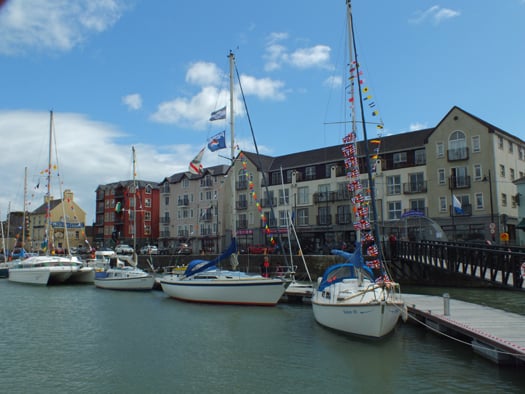
Dungarvan SC's new in-harbour pontoon has much improved the alongside berthing space, but unfortunately the local Council wouldn't permit dredging to improve access.......Photo: Donal Walsh

....and thus the reality for most boats in the Inner Harbour is a drying berth.......... Photo: W M Nixon
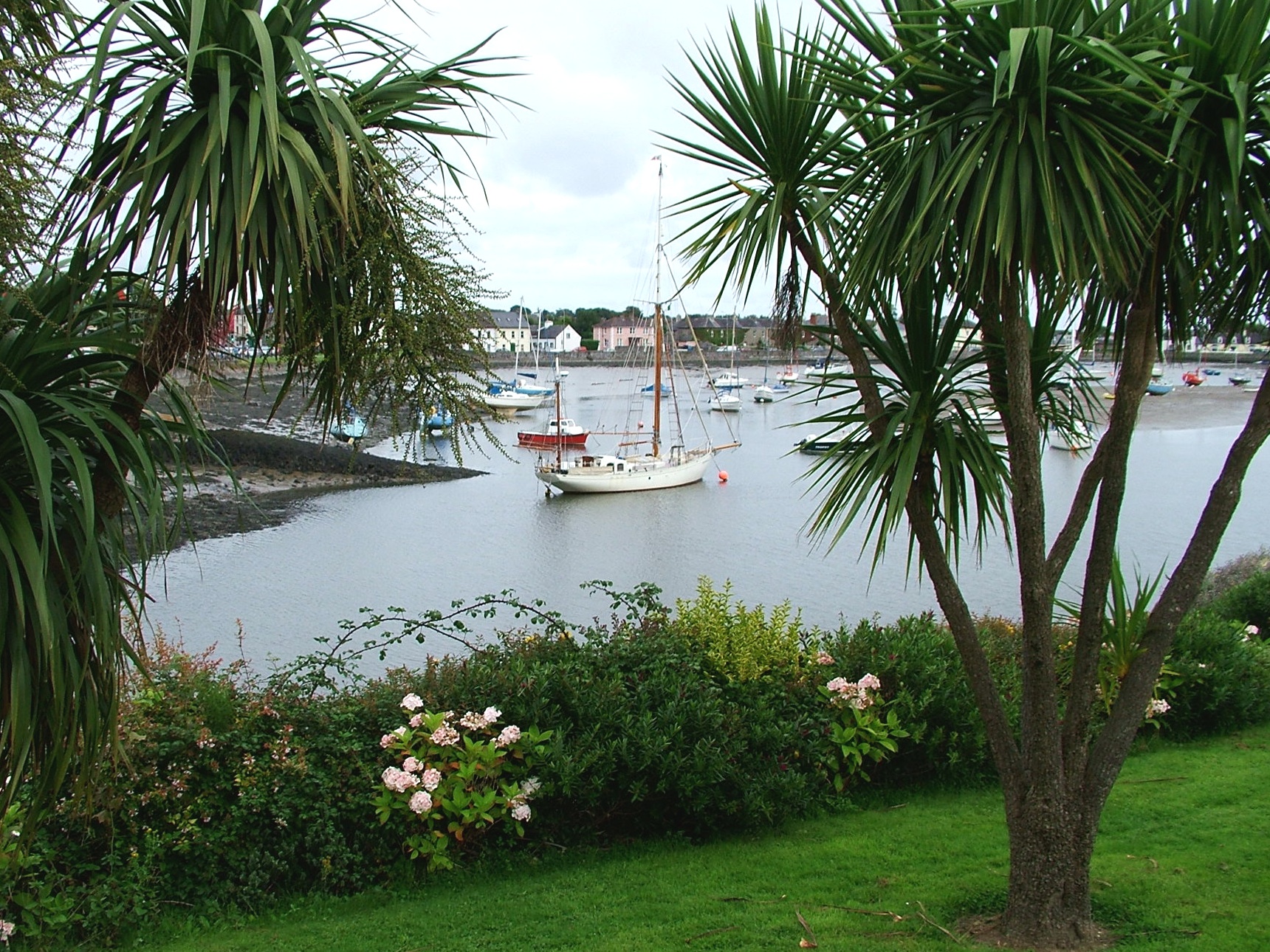
....but if you've access to local knowledge, there is a deep pool just below the bridge........Photo: Donal Walsh
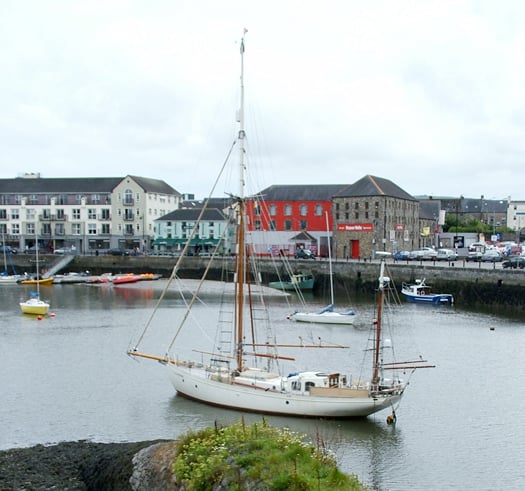
.....and here the Northwest Passage transiting 44ft steel gaff yawl Young Larry is visiting in comfort and style. Photo: Donal Walsh
Meanwhile in Dungarvan the club's hopes of doing a bit of dredging to improve access to their extended in-harbour pontoon was stymied when the council said they wouldn't permit any salt-contaminated sludge being brought up onto the quay. But despite its tidl limitations, it's a hugely hospitable place, and if you do take the ground at the pontoon, it's mostly soft and forgiving mud which enables you to sit in relative comfort. Certainly some very substantial cruising boat have overnighted here to enjoy the fine pubs both on the waterfront waterfront and in the town, while culinary standards are set by Paul Flynn's famous restaurant The Tannery just round the corner.
Nevertheless if you absolutely won't let your boat dry out, leading Dungarvan cruising man Donal Walsh (he has just returned from an epic round Ireland and Britain clockwise cruise with his Moody 31 Lady Kate) well knows the deep pool across the harbour close under the bridge, and he saw to it that his brother-in-law Andrew Wilkes and sister Maire Breathnaith found a secure berth there for their hefty 44ft steel-built gaff yawl Young Larry, a boat in which they transited the Northwest Passage, but she looks well at home in Dungarvan with its fine tradition of first class locally-based trading schooners.
In moving along the south coast, we find that when possible, they'll lay out the welcome mat big-time in Ballydehob, Youghal, Villierstown and Dungarvan, despite the fact that all four places are restricted in what they can do by the exigencies of tide.
So how are things working out in Dunmore East, the one port which has the potential to be one of the most welcoming and accessible all-tide sailing and fishing ports along the entire south coast?
Despite this potential, the under-development of its facilities, fuelled by a sometimes poisonous attitude between fishermen and other harbour users, has provided recreational visitors with often unpleasant memories. In trying to understand why this might be so, we have to understand how Dunmore East came to get its pretty little harbour. When it was built in the first half of the 19th Century, it was not – as is commonly supposed – built for the benefit of fishermen. The horrible fact is that fishermen came so far down the pecking order that they just had to make do for themselves as best they could.
The handsome new pier at Dunmore East, designed by Alexander Nimmo who is best known for developing Tobermory in Scotland and many places in Galway including Roundstone, was constructed exclusively for the use of the new fast sailing cross-channel packet boats serving the top people of Waterford in their trading and communication with Britain, while the unfortunate local fishermen were forced to keep their boats in the limited shelter of The Cove to the north of it, and haul them on the exposed beaches at The Strand and Councillors Strand.
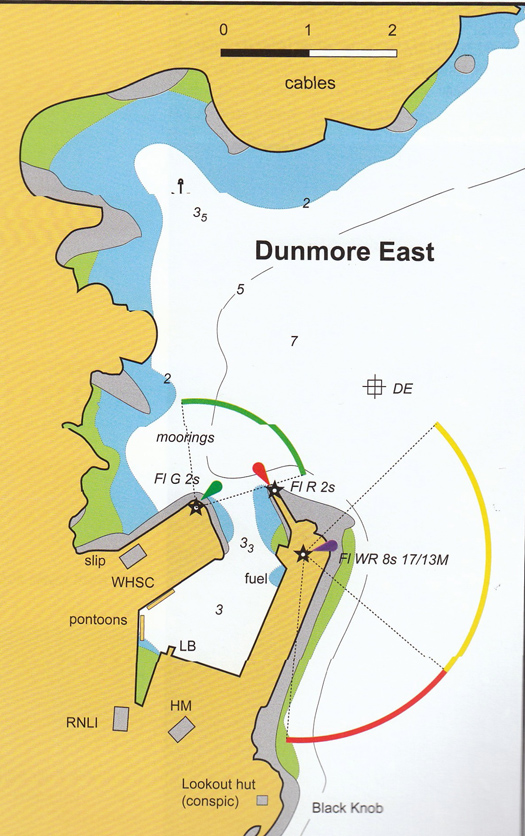
Dunmore East's substantial pier was new-built originally to provide a port for cross-channel sailing Packet Boats, serving Waterford ten miles up the road. When this was its primary function, any local fishermen were banished to the poorly-sheltered coves to the north, with their boats being hauled up on the exposed beaches beyond. Plan courtesy Irish Cruising Club
Soon, however, steam driven packet boats were able to go conveniently all the way up to Waterford, and Dunmore East was redundant as a packet-boat harbour. But it was only with reluctance that fishing boat were allowed to start using it, as the Royal Navy would have been keeping an eye on its possibilities for their own occasional use.
Yet down the years, the idea has developed that Dunmore East was always primarily a fishing harbour, and to a lesser extent the same attitude prevailed at Howth on the east coast, where the new harbour functioned as the Packet Boat station for Dublin only between 1817 and 1826, when the developing new asylum harbour at Dun Laoghaire became the selected port for the Royal Mail's new paddle steamers serving the cross-channel route. Yet the silted harbour at Howth was only allowed to become a "fishing station" in the 1850s.
The legacy of all this, in Dunmore East at any rate, is that there still seems to be a suspicion among the fishing community that their tenure is only temporary, that the powers-that-be would move them out if they see a better use for the place. How else can we explain the negative and almost paranoid attitude of the fishing spokesmen every time a suggestion for a much-needed marina at Dunmore East is put forward?
With all this in mind, I made a quick visit to Dunmore East in mid-August while on other business in the southeast, in the hope of seeing if a much-trumpeted €4 million dredging scheme was now in progress in the harbour, and also to see how an equally celebrated new Visitors Pontoon along the East Pier was working out.
The photos speak for themselves. There wasn't any sign of a dredger, though doubtless that will turn up in due course. Yet as for the 40 metre pontoon, it's not a leisure-boat-friendly neat little piece of work at all, but is quite a massive and brutal steel box structure more suited to rugged fishing boats, who were showing their approval by using it so totally that the only leisure visitor was a German motor-cruiser which had managed to squeeze in at one end.
But as this pontoon is on the wrong side of the harbour for ease of access to the Sailing Club on the west side, and the welcoming facilities in the village above it, any pedestrian boat visitor – the vast majority of incoming leisure boaters, in other words – has a long trek through the sometimes crowded and malodourous delights of a fishing port before they can access any amenities. So not surprisingly the German boat had its inflatable tender moored outside it for quick and easy movement across the harbour, and along to the beaches if wished, a situation which inevitably precluded any other newly-arrived boat from rafting up alongside
So for any cruising boat coming in from sea, often with the challenge of Hook Head just recently put astern, it wasn't a welcoming setup. In fact, it was downright hostile. While we were there, an ordinary sailing cruiser with happy folk aboard came motoring from the eastward to round the end of the pier after stowing their sails, but their hopes of a convenient and enjoyable visit to Dunmore East were soon dashed. No welcoming RIB came out from the sailing club to direct them to a vacant mooring, as there probably wasn't one. And as for the pontoon, "unwelcoming" is inadequate. It clearly didn't want anything to do with them. You could see their spirits wilting as they headed out, faced with the long haul up to the marina in Waterford City. The current visitor berthing situation in Dunmore East is at the very least a sad business, so where does it go from here?

Dunmore East in mid-August. No sign of any dredging, and the "Visitors Pontoon" under the lighthouse on the East Pier is packed out with fishing boats.......Photo: W M Nixon
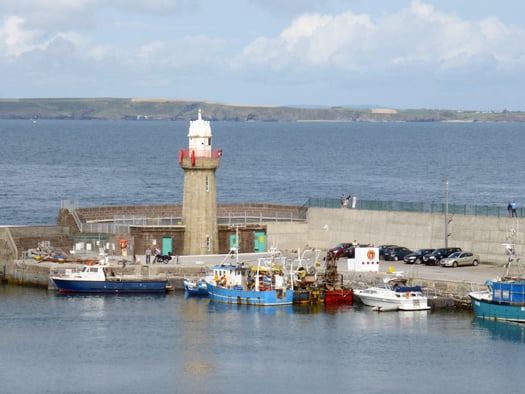
........and just one visiting German motor cruiser which was protected against any rafting up by its tender on the outer side. Photo: W M Nixon

The new pontoon is an industrial standard piece of kit......Photo: W M Nixon
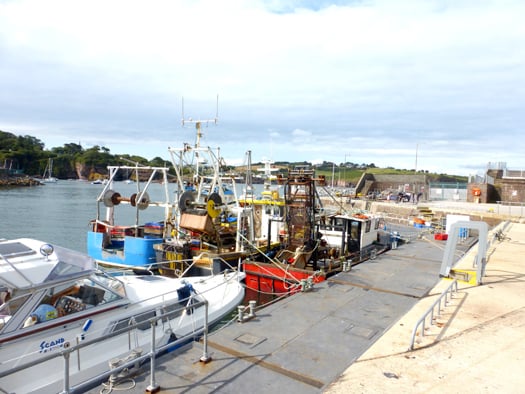
....and understandably very popular with active fishing boats. Photo: W M Nixon

But for visiting sailing boats newly arrived in port.......Photo: W M Nixon
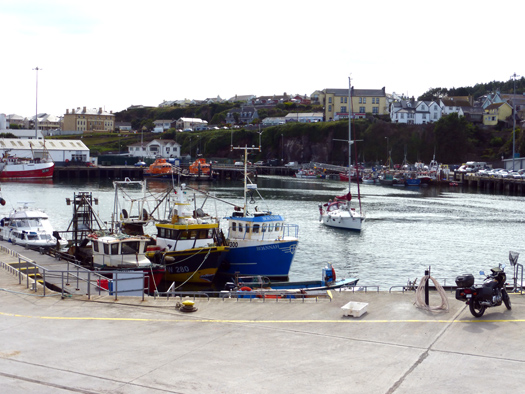
....it's soon clear that there isn't really a welcoming berth for them.....Photo: W M Nixon
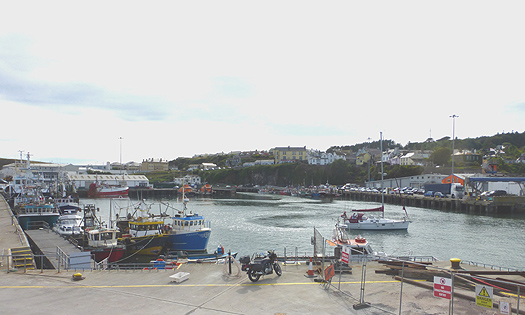
....and they head out to sea again, visibly disappointed by their Dunmore East welcome. Photo: W M Nixon
#coastguard – The Coastguard is this afternoon coordinating a rescue response after approximately 100 sailing dinghies at the GP14 world championships hosted by East Down Yacht Club were hit by stormy weather on Strangford Lough. A major incident has been declared.
Belfast Coastguard was first contacted just before 2pm reporting that some of the boats had capsized, while others were struggling to cope in the strong winds and squally showers.
The Bangor and Portaferry Coastguard Rescue Teams, the Portaferry and Newcastle RNLI lifeboats, the Irish Coast Guard helicopter along with the helicopter from RAF Valley have been sent to the scene.
It is not clear at this time how many people are involved and if there are any injuries. A search and rescue operation is ongoing.
Further update as we have it
O'Connor and McHaile Win Sligo's GP14 Open
As ever Rosses Point in Sligo was a beautiful spot to arrive to bright and early Saturday morning. Some may have been up at an ungodly hour, but it's well worth it to come to the top of the hill and look down on a line of peeling surf, a clear sky and a strong breeze.
Race officer Gus Henry had us out early because he had four races to run off each day, two for the Open in the mornings and two for the Youths in the afternoon.
Once a year owners lend their most precious possession to sailors under the age of 23, the hope being they might get a gra for what we do. How could you not when it's blowing like that ?!
First race Saturday morning set off in a good breeze, nice square line, and enough room so we could all get away nice and clean. Steven and Jonnie looked to put the gold fleet to the sword and bet on the right hand side in emphatic style,no doubt what they thought would work. Having worked our way up the middle I'd like to think that they made that side look a lot better than it was just because they eat up the beats in a breeze. Those that had heavily split to the left came in looking just as good. As always if you could hook into a gust on the reach, you might just hold on to it and escape, and it seemed to be a feature of the day ,as ever, that a little bit of luck might put you in the path of something the others might not get.
The second beat found the leading boat having to try and cover a heavy right/ left split from the four closest pursuers ( guess which way Steven went ! ). But again, there wasn't much in it.
Some crews struggled a bit on the beats, and some even fell out but if they could hold even a slim gap, they would usually escape down the reach to set themselves a wee cushion. Coming down the final run the leader was going to need it. Paddy and Tania survived a late surge from the chasing pack to record a fine race win. Ah, the sound of gun...such a glorious thing....
Race two and the Race Officer raised the Black Flag, he had no intention of pissing about wasting time. This made some of us a little nervous and I know a bo.at that was very gun shy, Dessie and Keith however happily set off on Port at high speed and only one boat pushed them back into the middle of the course.Dashing their dream of owning the right hand side, and what they belived might have been eternal glory. It wouldn't have been. Niall with Oisin back in the boat, popped around the top in a good position having worked their way up the left late in the beat and set about reminding the fleet how good they can be. But they had the previous race winner and a few others besides to contend with. A fast reach, an exchange of opinions at the gybe, a climb on the next leg, no-one quite brave enough to go straight and risk others coming over the top ,the only real decisions came at the leeward mark. Paddy and Tania went left, and gained massively putting them right in contention, they protected their lead aggresivley down the final run, forcing a penalty on one of the competition, and in the process nearly losing 3, 4,5, and 6 who were nose to tail down the other side of the course and going faster. But they popped around the bottom just ahead and held on to record another bullet. Ha, who needs a six time National Champion in the front of the boat when you've got Tania !
Next up the Youths who were to bear the brunt of a strenghthing breeze, bits started breaking off boats and quite a lot of swimming interspersed a game of follow my leader, when someone took them all off on the wrong course....The RO gamely set them up for another one in the strongest breeze of the day. They all came ashore with grins on their faces , Especially Dan Gill who won the only Race.
A great feed was enjoyed in the Sligo Yacht Club , and a few dice were rolled to decide the fate of a nice new GOACHER spinnaker sponsored by the Grangecon Café in Blessington .
The spinnaker was a reward for those owners who had kindly lent their boats to juniors, thank you to all of you.
Next up the Hot Toddy in Mullingar. Fresh water to wash your boat in and the possibiity of new sails as prizes just by entering the event.
Olympic Effort Did Not Shift McCarthy and Davis
Eagle eyed observers will most definitely have spotted Beijing Double Olympic race winner Gerald 'Gerbil' Owens is racing GP14s these days; a newsworthy point that escaped an earlier report about last weekend's event. Here's a more detailed Leinsters 2010 Event Report by Ruan O'Tiarnaigh that describes how Shane McCarthy and Andy 'Taxi' Davis fought off a determined effort from Owens and Melanie Morris to take the Championships at Skerries SC.
It was a tricky weekend in Skerries. Not as tricky as in Crosshaven where Niall Henry and James Conlon were representing the GP14 class at the All Ireland Sailing Championships, or the event formerly known as the Helmsman's, which saw no racing in the finals on Sunday, and the organisers looking for another date to bring those who qualified from the preliminary rounds back to Cork to decide on a winner. Niall and James will be there, and our best wishes go with them.
However despite the vagaries of the weather, PRO Liam Dineen made a fine job of providing races to the 40 strong GP14 fleet.
Racing Saturday began in near perfect conditions, as the fleet enjoyed 12-15kts of breeze from the North. A number of early casualties, which included Shane McCarthy and the dynamic pairing of Paddy O'Connor and Tanya McHale from Sligo, were caught for speeding at the start, and were rewarded with OCS's at the finish. Shining lights in Race 1 were the McGuinness Brothers, John and Donal, whose first place marked the highlight of their day as subsequent races saw a gradual and determined fall down the rankings.
Second in race 1 was the master boat builder Alistair Duffin and crew Paul Whitcombe from Newtownards and East Down respectively, who sailed a great race in the shifty conditions. Third place went to the team of Ruan O'Tiarnaigh and Libby Tierney, Ruan making a guest appearance in Simon Cully's stead.
The wind speed was falling, and with that brought an increased randomness in its direction. That coupled with the strong Skerries tide made for exciting, if somewhat mentally taxing racing conditions.
Race 2 started with a significant backing of the breeze. Out of the melee were the usual suspects, with Olympic 470 sailing legend, Gerry 'Gerbil' Owens and Melanie Morris establishing an early lead. Despite best efforts of the fleet, the experience and skill of the team were sufficient to maintain and even stretch a lead to the finish. Alistair Duffin and Paul Whitcombe again took the runners up spot and Shane McCarthy and Andy Davis finished good third.
Race 3, and the fleet were somewhat thrown after the start with a severe veer, but riding high in a new Duffin boat was veteran GP14 sailor Raymond Morrison with Brian Morrison streaking into the lead at the first mark, benefiting from the 30degree rightie. Raymond and Brian sailed a marvellous race to finish third, behind Gerbil Owen who took the gun, and Shane McCarthy in second.
In anticipation of little breeze on Sunday, the PRO raced a 4th race on Saturday. This proved to be as tricky a race as any this commentator has seen. With the Skerries tide in full swirl and the breeze in non-committal humour, the fleet once again headed towards the north with trepidation. The race was led at the first mark by newly elected president Richard Street and Dan Crilly from Blessington. This race was nip and tuck between the Blessington duo and the teams of McCarthy & Davis, and Clive and Philip Goodwin. Despite having lost the lead 'el Presidente' regained it to cross the line first, alas this was not greeted with the sweet sound of a hooter, as the duck egg coloured boat had started prematurely, and so the victory went to McCarthy & Davis with Goodwins in second and O'Tiarnaigh & Tierney taking third much to their relief, having been up and down the placings throughout the race.
Overnight saw Shane McCarthy and Andy Davis lead with 6 points, Owens and Morris on 7, the Goodwin's on 11, and tied for 4th on 13 points the teams of Duffin & Whitecombe and O'Tiarnaigh & Tierney.
Very notable on this day was the team of Diana Kissane and Niamh McCormack who were consistently at the business end of the proceedings and chalked up a 7, 5, 4 after their inaugural warm up in race 1, which left them lying in 6th overnight.
The forecast for Sunday was for dying breeze, and the weather did not disappoint in that regard. Another tricky day with great variations of strength and direction lay ahead.
Team Goodwin established an early lead in race 5 which they maintained through to the finish, with McCarthy and Davis in Second. The McGuinness brothers finished third having made a recovery that Lazerus would have been proud of, given that they found themselves in what is commonly known as 'a challenging position' on lap 1. A tack hard right on the third beat propelled them back into contention courtesy of a line of stronger breeze. Once again the pairings of Owens & Morris and O'Tiarnaigh & Tierney were in the shake-up finishing 5th and 4th respectively, with only inches separating them at the line.
Into the final race the pressure was on team of McCarthy & Davis who were carrying an OCS from Race 1. However it was to be their day as they led at the first mark, and despite the persistent and sustained attentions of Owens & Morris, the 'Team Speed Sails' duo maintained a slight lead to take the gun and also the title.
Second in the final race and also second overall were Owens and Morris, followed closely by the Goodwin team and O'Tiarnaigh & Tierney in 4th with the McGuinnesses in 5th.
The silver fleet was comprehensively won by Diane Kissane and Niamh McCormack from Howth YC who finished 8th overall with Doire Shiels and Sean Collins second and Cathal Sheridan and David Cooke only a point behind on the overall classification, both boats from host club Skerries SC.
The bronze fleet was a close run event with only 5 points separating the top three boats. The final result saw Gary Rock and Gosia Oleskow from Mullingar SC first, Jonathan Cully and Oisin McCelland, BYC, second, and Noel Clarke and Paul Kelly from Skerries SC third.
The evenness and versatility of the GP14 was commented upon by Gerbil Owens. 'It is amazing that ages from 15 to 65, and from light to heavy weight teams are all accommodated so well by the GP, and the racing is fantastic.






























































